



Low Pressure Fitness
Pelvic Organ Prolapse (POP)
The Silent Epidemic
Pelvic Organ Prolapse (POP) occurs when a pelvic organ (i.e. bladder or uterus) drops down (prolapses) and pushes down and/or descends into the vagina. Prolapse comes from the Latin word meaning to fall. A prolapse can go unnoticed, presenting with little or no symptoms until it gets to the stage where it protrudes and effects a woman’s daily life. It can have a huge impact on body image, exercise and sexuality.
There is more research being conducted on POP today than ever before. Studies until now have been more guesstimates due to the sensitive nature of the area and embarrassment related to the symptoms. But as of now, the 'guesstimates’ are mind boggling. It is estimated that almost half of the female population will experience some degree of POP.

There are 5 main types of POP (with the first 2 being the most common)
1) Cystocele - (Bladder) - The bladder pushes into the vagina.
2) Uterine - (Uterus) - The womb drops down into the vagina.
3) Enterocele (Intestines) - When a space opens between the vagina and rectum, the bowel can bulge through.
4) Rectocele (Rectum) - Occurs when the Rectum pushes and protrudes into the vaginal wall.
5) Vaginal Vault (Vagina) - For some women who have had a hysterectomy, without the attachment of the uterus to hold it in place, it is possible for the vagina to fall or fold down into itself.
There are 4 levels of severity that are used to rank the degree of a prolapse with 1 being the least severe progressing to 4.
Stage 1 - Very minor prolapse. The organs are still supported, but have shifted downwards.
Stage 2 - The organs are not being supported fully by the pelvic floor and have begun to descend down into the vaginal canal.
Stage 3 - The organs have descended to the point where they are beginning to bulge at or beyond the opening of the vagina.
Stage 4 - The organs have descended and are now protruding outside of the vagina.
Potential Causes
The actual cause of an individuals POP may be hard to pinpoint due to the multitude of potential causes. These can include, but are not limited to:
- Vaginal Childbirth
- Genetics
- Heavy Lifting
- Hysterectomy (Or other pelvic surgery)
- Chronic Cough - leading to constant pressure
- Straining with Constipation
- Hormonal decline or age related
Why do females suffer from Prolapse?
First, you must realize that the structure of the female anatomy already makes us prone to pelvic floor issues. Take a look at the picture below comparing the female to male anatomy. Notice how large the opening of the pelvis is for the woman? The obvious reason for this is child- birth. However, this opening leaves a lot of vulnerable structures due to the potential causes listed above.

Some people have compared the pelvic floor to a hammock. While I am not particularly fond of this description - it does make sense to a point. If you have a rope hammock that is constantly bearing weight, enduring weather and time, what happens to the hammock? It begins to sag and deteriorate. Eventually, one day you go to sit in it and it tears, plopping you on the ground.
The same sort of principal can apply to your pelvic floor muscles. Weight, strain, age, pressure etc., can all lead to weakness leading to that unfortunate day when an organ slips through.
The Good News?? There is Hope!!
Hypopressives, Low Pressure Fitness has the ability to retrain and stabilize the pelvic floor to help keep everything in it's proper position. It has been a proven, effective method for a non-invasive, non-surgical rehabilitation of stages 1 and 2 prolapses. It has even been shown to help alleviate some of the symptoms associated with level 3. Unfortunately, if you have reached a stage 4 - I hope that you have already sought medical advice and are being treated (which the only option that I know of at this time is surgery.) However, that said - Hypopressives can help you continue to stabilize your core after the surgery.
Check out these quick video from the news in Canada with Hypopressives Master Trainer Trista Zinn as she explains how Hypopressives can help with Prolapse and Incontinence. (PS - this is who I went to train under in Canada :D )
Please Note: If you think that you may have a prolapse, please consult your doctor or pelvic floor specalist. Not only is it prudent to do so, it can be a great indicator of success after you have completed your Hypopressive, Low Pressure Fitness training!
DISCLAIMER!!! The following links will take you to graphic videos.
These videos will show a woman's vagina and prolapse. If you are squeamish or embarrassed - please do not click on these links. If you are curious and one of those people who need to see the benefits of Hypopressives on an actual prolapse for yourself - please see the links below.
In this first video, you will first notice the organ that is bulging out of the vagina. Notice how when she preforms the Hypopressive technique, that the organ moves back up into the vaginal canal and you can actually see the urethra appear.
In this second video, you will see how coughing affects the pelvic floor and prolapse. Notice that you can see a small pink area of the organ that is prolapsed that protrudes from the vagina. Then she preforms a Hypopressive exercise and you will see how everything moves up and tightens up.